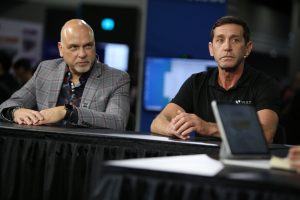 INFRA
INFRA
 INFRA
INFRA
 INFRA
INFRA
Since graphics processing units offer unparalleled speed, efficiency and scalability for specific tasks that are computationally intensive, GPU-accelerated workloads are critical in the artificial intelligence age.
The collaboration between Vultr’s composable cloud infrastructure and Advanced Micro Devices Inc.’s next-generation silicon architecture unlocks new frontiers of GPU-accelerated workloads, providing businesses with powerful, cost-effective and flexible resources to handle demanding AI functions, according to Kevin Cochrane (pictured, right), chief marketing officer of Vultr (aka The Constant Company LLC).

AMD’s Ted Marena and Vultr’s Kevin Cochrane talk to theCUBE about the relevance of GPU-accelerated workloads in the AI era.
“We have had a long-standing partnership with AMD,” he said. “On our core cloud compute, we are big consumers of AMD EPYC Processors to support some of the most complex cloud-native application workloads on the planet. HPC workloads as well. In particular, for our enterprise customers that are moving beyond the art of the possible in 2024 and moving into inference at scale for all of their agentic AI initiatives, it’s incredibly important that they have that inference-optimized, cost-efficient, energy-efficient GPU powered by AMD.”
Cochrane and Ted Marena (left), director of market development for GPU AI data center OEM/ODMs at AMD, spoke with theCUBE Research’s Savannah Peterson and Dave Vellante at SC24, during an exclusive broadcast on theCUBE, SiliconANGLE Media’s livestreaming studio. They discussed the instrumental role that GPU-accelerated workloads play in AI tasks. (* Disclosure below.)
By offering the parallel processing capability needed when handling large-scale and complex computations involved in AI tasks, GPU-accelerated workloads are becoming a game-changer in the digital landscape. As a result, they are an indispensable tool for both training and inferencing in modern AI systems, Marena pointed out.
“Our GPUs can do inference, they can do training, they do AI and HPC well,” he said. “Our ROCm software stack is an open-source software stack, and that is what we initially optimized for inferencing because we knew the market was moving there. The GPU technology, the performance, the tools, the ecosystem that we brought, companies like Vultr are taking advantage of.”
One of the primary objectives of the AMD-Vultr partnership is to provide enterprises with access to an industry-leading environment for AI development and deployment. As a result, this collaboration triggers a shift toward distributed computing for modern application development, according to Cochrane.
“It’s time to fast-forward from the early part of the 1960’s mainframe era of the market and get into modern application development, deployment at enterprise scale, which is distributed computing worldwide,” he said. “That distributed computing means you have distributed agents, which means you need to have distributed inference clusters, you need to have distributed clusters for fine-tuning. I think that’s the power Vultr brings to the table with AMD, because we have the global scale as an independent hyperscaler.”
Given that AI is changing the application stack, expanding developers’ knowledge base is vital. As a result, the AMD ROCm ecosystem enables developers to gain hands-on experience in optimizing and deploying AI workloads on AMD GPUs, expanding their expertise in high-performance computing and AI solutions, Cochrane explained.
“I think the key point is that every application, every website that’s ever been built is going to get rebuilt, and GPUs are going to be at the core, inference is going to power it,” he said. “The key is we have all of these developers all around the world, and they’re not AI engineers right now. They need to learn a new set of skills. I think the power of the ROCm open ecosystem that AMD is building is to lower the learning curve to get a whole new class of developers.”
Here’s the complete video interview, part of SiliconANGLE’s and theCUBE Research’s coverage of SC24:
(* Disclosure: Vultr sponsored this segment of theCUBE. Neither Vultr nor other sponsors have editorial control over content on theCUBE or SiliconANGLE.)
Support our mission to keep content open and free by engaging with theCUBE community. Join theCUBE’s Alumni Trust Network, where technology leaders connect, share intelligence and create opportunities.
Founded by tech visionaries John Furrier and Dave Vellante, SiliconANGLE Media has built a dynamic ecosystem of industry-leading digital media brands that reach 15+ million elite tech professionals. Our new proprietary theCUBE AI Video Cloud is breaking ground in audience interaction, leveraging theCUBEai.com neural network to help technology companies make data-driven decisions and stay at the forefront of industry conversations.